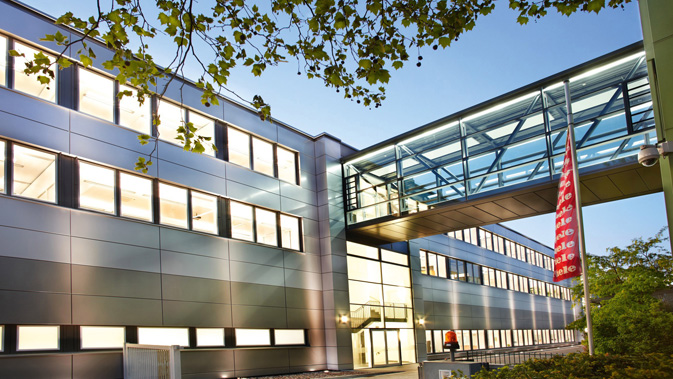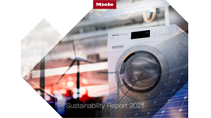Press releases
Faster, more flexible, more precise: Miele invests € 30 m in Miele Bielefeld

New innovation and production centre for Professional cleaning systems
Miele has recently thoroughly modernised and extended its production plant in Bielefeld: The newly created Innovation Centre for Professional Cleaning Systems (PRS), where all washer-disinfectors are designed and developed, plays a significant role in this constellation. This means that Miele can now respond faster, more flexibly and with greater precision to customer wishes – and to further enhance the legendary quality of its machines.
The family-owned Miele company has invested just under € 30 m since 2008 in the PRS facilities at its second-largest and second-oldest production site. The most well-known products to originate from the factory, founded in 1916, are vacuum cleaners and dishwashers for domestic use. But a little known fact is that one third of expenditure on research and development is ploughed into commercial cleaning systems. The equipment built belongs to the Miele Professional business unit and is destined for use in commercial operations, hospitals, doctors' surgeries and laboratories. Commercial products are developed and produced by 300 out of a total of 1800 Miele employees at its Bielefeld plant which is currently in the throes of introducing a completely new generation of products. 'A large proportion of our machines is being replaced by new model series', says Lutz Döhnert, responsible at Miele Bielefeld for commercial cleaning systems.
All new facilities are designed to minimise production times, keep inventory levels low and improve productivity. And, indeed, orders are now processed some 50% faster and stock levels have been reduced by 20% compared with previously. And, indeed, orders are now processed some 50% faster and stock levels have been reduced by 20% compared with previously. This has all been achieved with the latest production concepts, with € 10 m alone being invested in a new inner cabinet production facility. 'Thanks to these investments, we can work faster and more economically than before', says Döhnert.
Through step-by-step productivity gains agreed with shopfloor representatives, production can be increased by around 30%. Döhnert: 'With a view to anticipated unit sales, we can make good use of these additional capacities. And they help improve our position in maintaining a leading edge in terms of innovation and competitiveness at this site as a whole.' And, not least, Miele paid great attention to climate protection and the good husbandry of resources when investing in buildings and production plant and equipment: Energy consumption, for instance, in the new facilities was cut by more than 10%.
The cornerstone of the new production concept is proximity and the interaction of the new production facility with the completely new pre-assembly stage as well as the flexible automation of processes. Whereas the previous inner cabinet was seam roller welded, industrial robots are now deployed to seamlessly weld the sections of the cabinet together using laser welding technology, monitored at a safe distance by a single employee. Whereas the previous inner cabinet was roller welded, industrial robots are now deployed to seamlessly weld the sections of the cabinet together using laser welding technology, monitored at a safe distance by a single employee. The finished, cove-cornered chamber has no joints or crevices - a prerequisite for top-class wash performance later. Next, the fully welded chambers are picked up by suction pads and transferred to the next industrial robot further down the line. This allows a precise calculation of the units needed to keep downstream processes on the main and final assembly lines running smoothly.
Whereas pre-assembly and final assembly are now close together, production and assembly on the one hand and logistics on the other have been deliberately separated. Furthermore, assembly lines are highly flexible and able to cope with models changes, with short retooling times. Both contribute towards giving Miele the flexibility to cope with fluctuations in demand for lab washers and washer-disinfectors and allowing a varying number of employees to be deployed on the lines to meet demands on production. Significant productivity gains have been achieved, according to Döhnert. 'In the field of large-chamber decontamination units, machines are built individually to meet incoming customer orders. What used to take us up to two weeks is now completed in just 2 days.'
(706 words, 4,579 characters, incl. spaces)
Company profile: Miele is the world's leading manufacturer of premium domestic appliances including cooking, baking and steam-cooking appliances, refrigeration products, coffee makers, dishwashers and laundry and floor care products. This line-up is augmented by dishwashers, washer-extractors and tumble dryers for commercial use as well as washer-disinfectors and sterilisers for use in medical and laboratory applications (Miele Professional). The Miele company, founded in 1899, has 8 production plants in Germany as well as one plant each in Austria, the Czech Republic, China and Romania. 2013/14 turnover amounted to approx. EUR 3.22 bn with sales outside Germany accounting for around 70%. Miele is represented with its own sales subsidiaries and via importers in almost 100 countries. The Miele company, now in the fourth generation of family ownership, employs a workforce of around 17,660, 10,411 thereof in Germany. The company headquarters are located in Gütersloh/Westphalia, Germany.
Download as PDF Download incl. media (zip)
Anke Schläger
+ 49 5241 89-1949
anke.schlaeger@miele.com
Media information
| Description | Download |
|---|---|

The first workstation on the new pre-assembly line at Miele's Bielefeld plant, producing chambers for commercial dishwashers and washer-disinfectors. The photo shows the lower section of a chamber in the shaping process while an awaiting industrial robot in the background holds the matching upper and central sections. From here, inner cabinets progress to the laser-welding cabin visible rear right. |
High Resolution TIFF |
| High Resolution JPG | |

Before welding, the central section of the chamber is formed into a U on a so-called tangent bender which can be seen on the right. |
High Resolution TIFF |
| High Resolution JPG | |

Second stop on the new pre-production line: A robot places the finished chamber on a conveyor which transports it to the next stage of production. A turntable, visible on the far right, proffers the individual sections of the chamber to an industrial robot. Parts are replenished on the half of the turntable outside the cubicle by an employee. |
High Resolution TIFF |
| High Resolution JPG | |

Chamber production at a glance: The first two stages – forming and completing the chamber – can be seen in the background. This is followed by passivation (left centre) which involves degreasing and drying the chambers. Work in progress is then taken by conveyor belt to the bitumous felt kilns (right centre) where sound- and heat-proofing mats are applied to five sides of the 'cube'. At a further welding station (front right), load-bearing legs and reinforcement struts are welded onto the chamber before units are handed over to the pre-assembly line (front left). Here, for example, the upper spray arm and the door gasket are fitted – all other assembly work takes place on the main assembly line. |
High Resolution TIFF |
| High Resolution JPG | |

New: Assembly line for undercounter models used later by laboratories, surgeries and hospitals. |
High Resolution TIFF |
| High Resolution JPG | |

Precision workmanship: A line worker fits components on a new Miele lab washer. |
High Resolution TIFF |
| High Resolution JPG | |

Full concentration needed during assembly. Depending on production output, varying numbers of employees are deployed in assembling lab washers and washer-disinfectors. |
High Resolution TIFF |
| High Resolution JPG | |

'A large proportion of our machines is currently being replaced by new model series', says Lutz Döhnert, responsible at Miele Bielefeld for commercial cleaning systems. |
High Resolution TIFF |
| High Resolution JPG | |

A bird's-eye view of the new production building, where all new lab washers and disinfectors are built. |
High Resolution TIFF |
| High Resolution JPG | |

The new building on the site of the Miele production plant in Bielefeld. |
High Resolution TIFF |
| High Resolution JPG | |

An aerial view of the Miele Bielefeld production plant: The new Miele Professional Innovation Centre is located in the west of the site. |
High Resolution TIFF |
| High Resolution JPG | |


